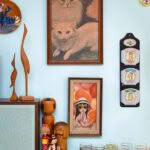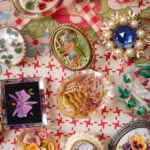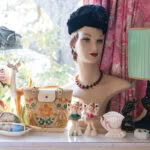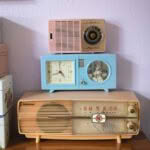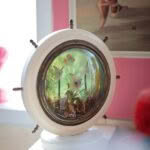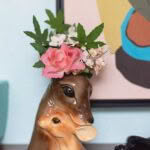Vintage for the soul: Retro décor and dresses never fail to brighten this collector’s day
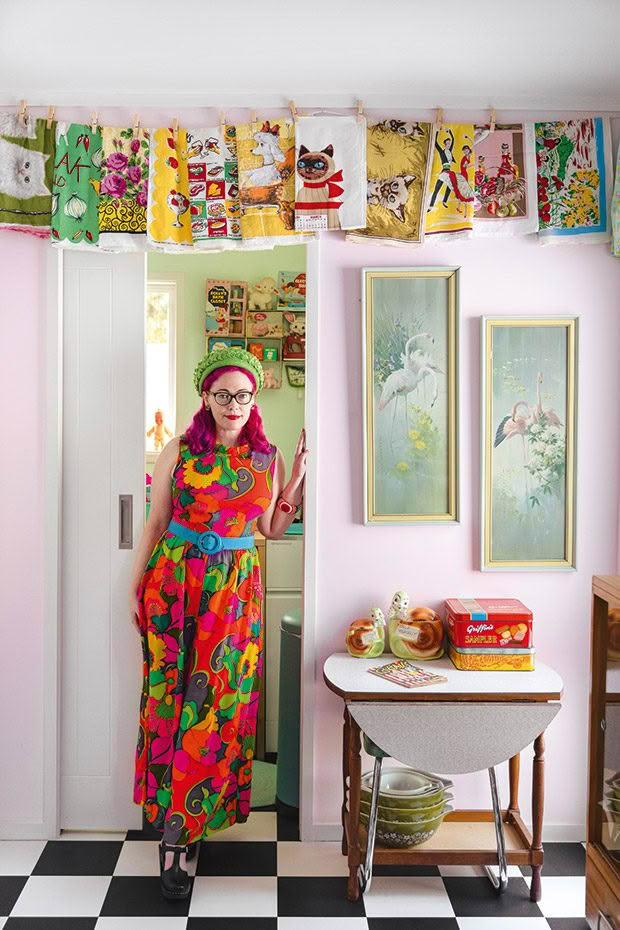
Despite managing a rare — and sometimes debilitating — illness, Natalie Robinson-Tantin is an active participant in a world she’s designed with living colour.
Words: Jane Warwick Photos: Tessa Chrisp
There’s a sort of freedom in vintage patterns from the 1950s and 1960s; a kind of wild, spit-in-your-eye bravado — for example, the John Russell-designed Dolly Days hostess ware in Natalie Robinson-Tantin’s kitchen.
The pattern by the renowned British ceramic artist is an unsophisticated five-petal flower on a straight stem with symmetrical leaves on either side. It is deceptively simple, the colours basic yet with a depth difficult to describe.

Perhaps that is why Natalie is attracted to vintage objects; sometimes, she must look life right in the eye and stick her tongue out. From the outside, she appears fine, but on the inside, her chronic condition Ehlers-Danlos Syndrome sometimes makes life tough, with a depth — like Russell’s design — difficult to describe.
The connective tissue disorder brings joint pain, headaches and digestive issues, so some days, the best a girl can do is retire to the couch by the beautiful vintage curtains, snuggle under her two cats and a blankie, and say quite rude things under her breath. Taking to the sofa is not a defeat; running concurrently with her EDS is Non-24-Hour Sleep/Wake Disorder, a circadian rhythm disease that turns her sleep schedule into anything but a schedule and leaves her, for example, wide awake in the early hours of the morning and knackered (there is no better word) in the early hours of the afternoon.
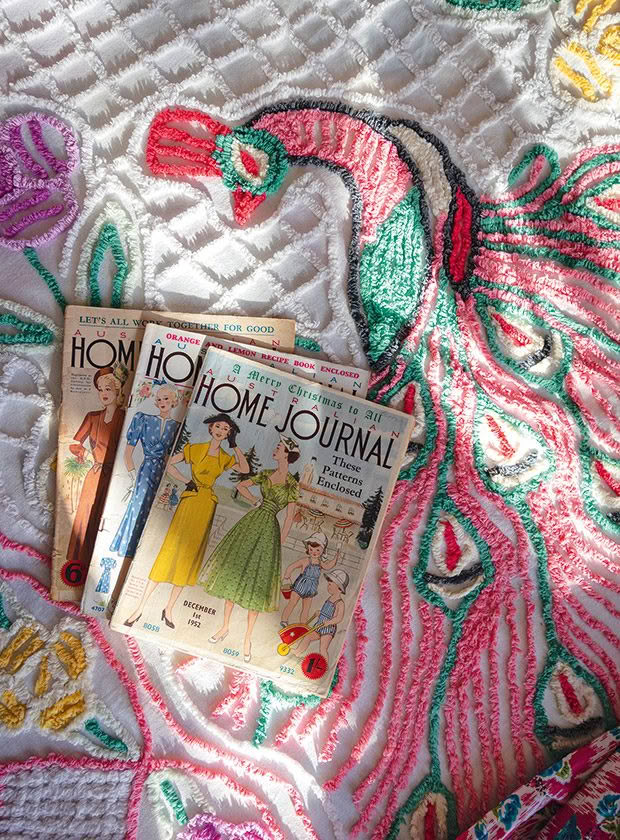
Issues of Australian Home Journal spread across Natalie and Tyler’s beautifully kept chenille bedspread. Chenille bedding reached the height of its popularity in the 1950s and was mostly crafted in Georgia (USA). Finished products would be displayed on clotheslines for sale to passers-by. In fact, a section of Highway 41 that passed through Georgia on the way to Florida became known as Peacock Alley because of the number of bedspreads on display, the most popular motif being the peacock.
So maybe, despite the fact Natalie has never lived in a dull space (her mother is an interior designer), it was Natalie’s health that subliminally led to her interest in vintage ephemera? After all, these objects were long expected to outgrow their usefulness and appeal but ultimately couldn’t be quashed. Like them, Natalie will not be defeated.
Joint pain and tiredness don’t confine Natalie to her home in the Auckland suburb of Glenfield all the time. There is a big world out there, and she is as active a participant in it as she can be. Outside of her home, she is an eager op-shopper. Inside, she is an administrator of the Facebook page, V is For Vintage, where several thousand members share posts on outfits, vintage finds from stores and online and show off spaces they have decorated.
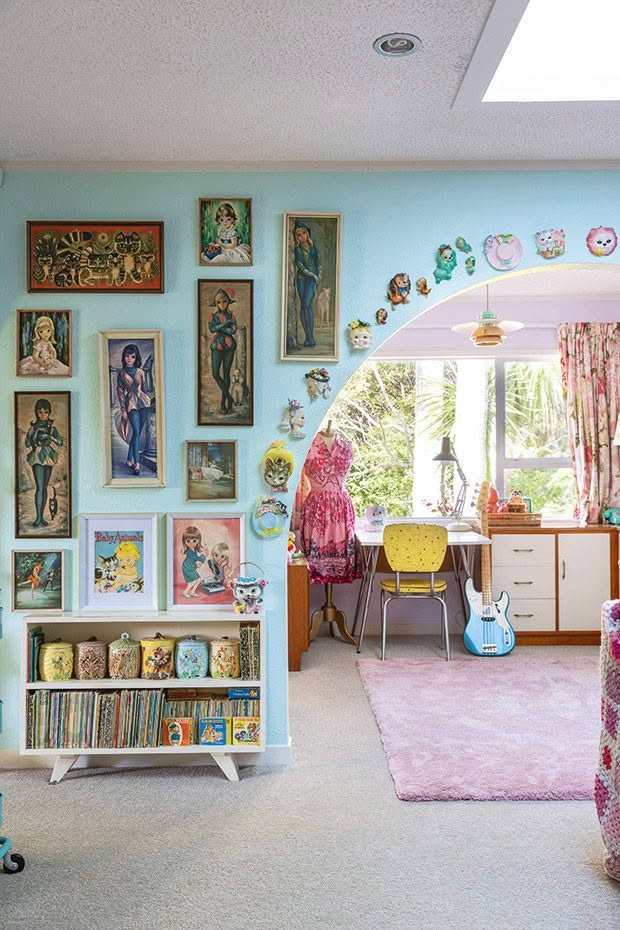
Prints of doe-eyed children, Rand McNally Elf books and plaster wall plaques decorate the walls and bookshelves of Natalie’s Auckland home. The trend for saucer-eyed children was believed to have been started by artist Margaret Keane, who died earlier this year aged 94. Rand McNally is one of the oldest print shops in the United States, beginning in 1856, and among the first to print children’s school text and story books.
Daily, however, it is Instagram that keeps Natalie connected to the world, especially those days when pain or exhaustion holds her back. For the past decade, the photo-sharing app — an incredible, mind-boggling technology unimaginable in those mid-century years that so enamour her — has helped Natalie make vintage-loving friends all over Aotearoa, and across the globe.
Collectors who share the same passions for — at times — very niche things, such as the huge-eyed Japanese pose dolls whose limbs posture without pain, the kitschy-cute animal ornaments that can coax a smile from behind a migraine and 1950s novelty-fashion dresses to lift tired spirits.
- The record collection, more Tyler’s than Natalie’s, is a random assortment from the 1960s and 1970s — David Bowie, the Beatles, Beach Boys, etc.
- The modern Japanese porcelain ware draws attention to the older wooden kokeshi dolls on the bureau.
- The dolls’ simplicity echoes that of the mid-century Danish heron pieces above. Beside the kokeshi is a Margaret Keane print.
Natalie wears vintage pieces integrated into casual outfits most days. “I have an extensive collection of vintage cardigans from the 1950s and 1960s. They can be worn with literally anything. I wear full vintage for events and occasionally when I’m going op-shopping or to Sunday markets. Sometimes I get dressed up for fun at home or want to share a new dress I’ve found.
“It’s been incredibly difficult to accept that my chronic condition will never change. For example, I might be fine one Tuesday and awake until 6am the next. But one thing I can do when feeling crappy is put on a colourful dress. It can be a great pick-me-up.
“I have pieces from the 1940s through to the 1970s and love wearing and mixing all those eras. I’m not a purist, and I think there are no rules regarding fashion. My favourite things to wear are 1950s novelty dresses; they come in the most fabulous prints.”
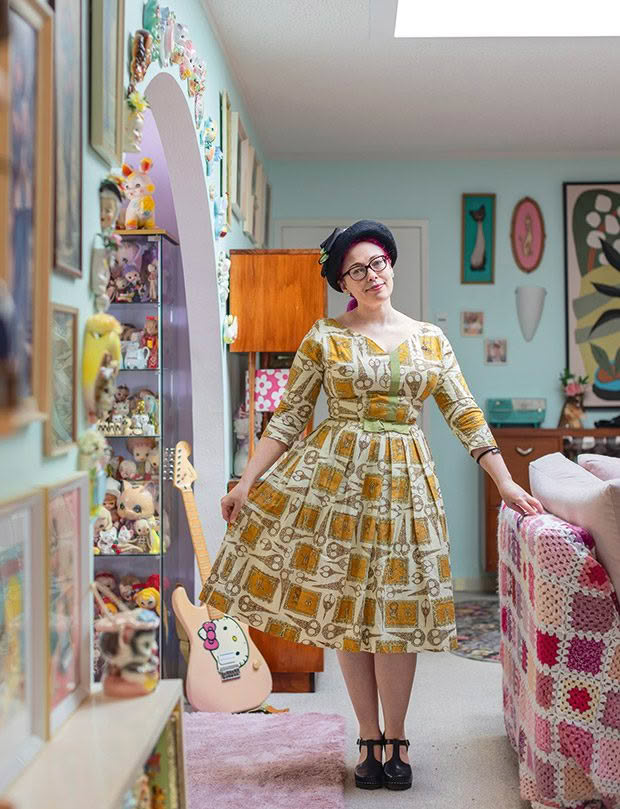
Natalie in a 1950s dress made from a novelty print of embroidery scissors. Behind her is a Hello Kitty guitar, the HK design undoubtedly the vintage logo of the future.
But Natalie is adamant that vintage-loving should not be confused with vintage values. “Some people confuse interest in vintage with also loving the way society was back then. I’m firmly a very modern girl and would never want to bring back the attitudes of those times.”
Natalie shares her own spaces almost daily on Instagram. She and her husband Tyler Tantin redid their kitchen, laying a black-and-white checkered flooring. She longed for a 1950s-style pink fridge, but they were way too expensive, so she got clever with some special contact paper she found online, and now she has the perfect Natalie refrigerator. The windowsills and cabinets display such finds as the Russell tableware and the strawberry-themed Pyrex dishes, which were made especially for the Australasian market.
- A colourful collection of Pyrex and china jostle for space in Natalie’s kitchen cupboards and on the kitchen bench that she and Tyler transformed into vintage splendour.
She and Tyler also painted each room in the house a different colour, except for the entranceway and hall, which they left white as a sort of palate cleanser.
The doorway into the lounge is the portal to Natalie’s collections. On a shelf just inside is her Japanese grandmother’s wooden kokeshi doll, an item from Natalie’s childhood that probably also played a part in her interest in vintage items. On the wall is a starburst clock, one of her favourite finds, and beyond the couch, a spinning rack of Little Golden Books. Natalie’s treasures are displayed all around, mostly behind glass because everyone knows a cat (or two) cannot bear to see an object balanced tantalizingly close to the edge of anything.
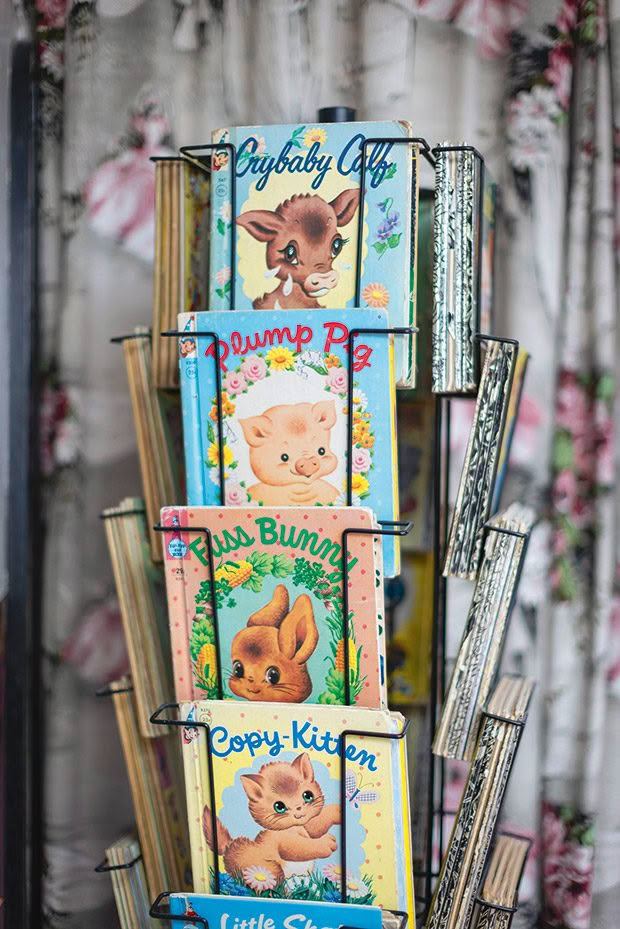
Natalie’s Little Golden Books and Elf Books (her favourite) on a revolving stand — she reckons she has more than 150 (she has never counted), dating from the 1940s to the 1980s.
Eisley the tonkinese and Yuki the burmilla must have great strength of character not to explode on a whirlwind of gleeful “take that!” destruction, although Natalie can catch them looking contemplative. If rumbled, they quickly look away with deliberately widened “who me?” eyes. Natalie says one can’t be precious about things with cats, so it is probably just a matter of feline time.
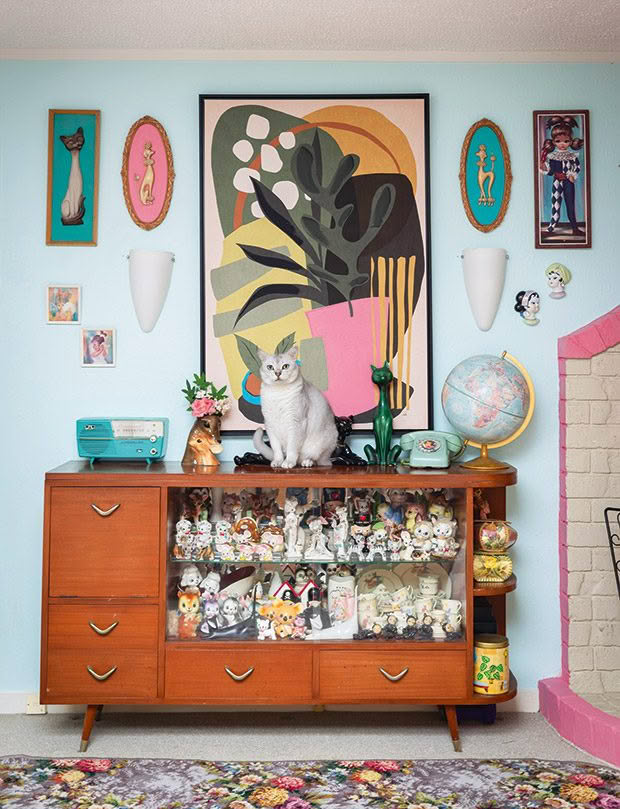
Yuki the cat does her best De Niro “You talkin’ to me?” impersonation, or does she just think — sniggering into her paw — that if she sits still, Natalie will mistake her as a twin to the nearby mid-century cat figurine? Her owner painted over the print behind her with colours suited to her vintage tastes.
On the other side of Natalie and Tyler’s chenille bedspread with its peacock motif is a rack of her beautiful vintage dresses, and on the lowboy are bracelets, earrings and brooches to complete the look. There is nothing for Tyler because vintage menswear is difficult to find, and if an item does surface, it is, for reasons unfathomable, usually in tiny sizing. But he certainly appreciates the fashion period and does have some vintage-inspired shirts.
Down the corridor, the door to 16-year-old Lily’s bedroom is a demarcation point between her mother’s style and hers. There was a time when this excess of “old-fashioned” furnishings was a bit of an embarrassment for Lily in front of her peers, but she has come to appreciate it and is not at all opposed to bringing friends home.
She has also found a few vintage coats that complement her more minimalist preference for jeans and Dr Martens. Nevertheless, her room has its own stamp, her own take on style and reflects her creative interests as a budding artist.
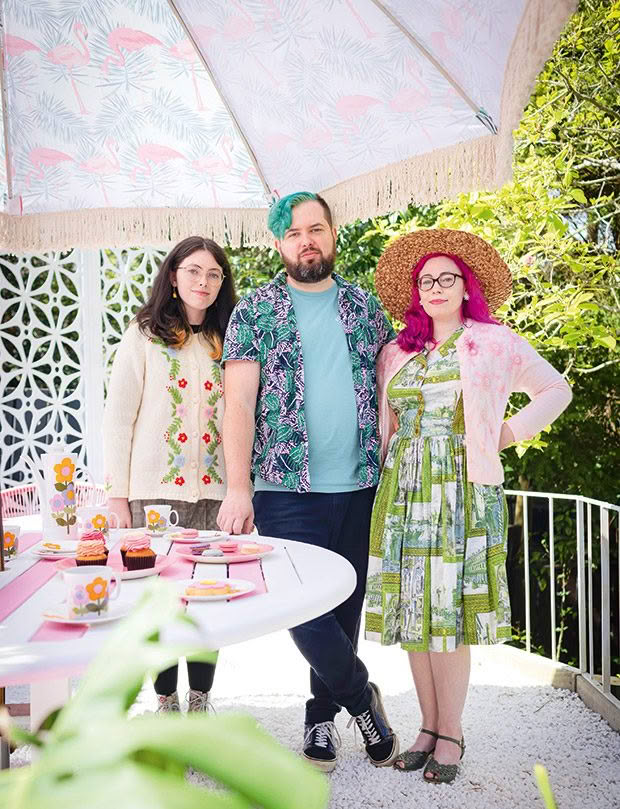
Tyler Tantin with Natalie and their daughter Lily. Lily wears a cardigan pinched from her mother. The 1960s wool-embroidered garment was made in Hong Kong, where almost all beaded and embroidered cardigans from that time were made. Natalie’s pink cardy is also a 1950s/1960s item from Hong Kong, while her frock has a vintage print of Venice.
Tyler is Natalie’s greatest enabler. He encourages Natalie otherwise when she endeavours to show restraint in front of an op-shop bargain. Originally from California and now in Auckland via his grandparent’s home in Kaiwaka, he also appreciates the attraction of vintage items. After all, he says, when anyone is into a certain thing, they almost invariably go looking for its vintage version. As a sound engineer, his interest is in vintage microphones and audio equipment.
There is an element of nostalgia linked to collection in any form. There is history in every object, and if an item fits perfectly into your hand, its role in your life is almost inevitable.
- Snapshots of a vintage world. In the 1960s, plastic replaced traditional materials because of its affordability, versatility and ease of manufacture, allowing cheaper access to household items such as radios.
- The ship’s-wheel aquarium lamp was a popular kitsch item in the 1960s, as were bisque porcelain figurines.
- Royal Copley of Ohio (1939-1960) was well-known for its china vases picturing human and animal faces. The example with the deer and fawn was especially favoured.
- The Dolly Days tableware makes a pretty outdoor service.
How big a part is open to debate. Even Natalie, with her carefully curated collection, is still unsure if gathering these pieces is a hobby or a lifestyle. But she knows it is a big part of who she is.
EYES WIDE OPEN
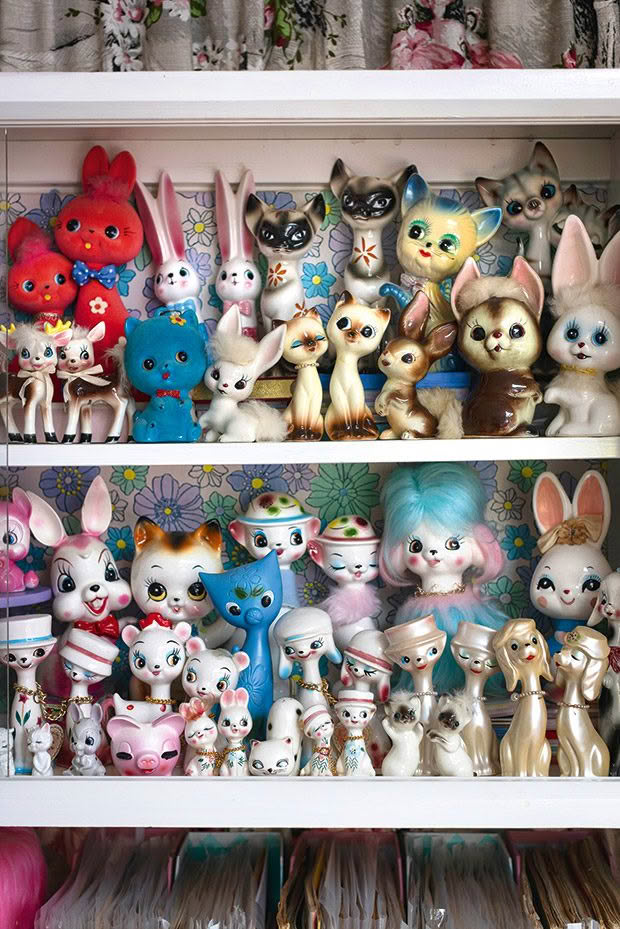
Dolls with large and emotive eyes are extremely popular in Japan, as reflected in today’s anime graphic novels, for adults and children.
In the West, the depiction of doe-eyed children is attributed to American Walter Keane. Keane was in Berlin after World War II, learning to paint and noted the famished children of post-war Germany, their eyes big with hunger. He attempted to paint them but his artistic talent was really non-existent.
However, his wife, Margaret, could paint and did, on his behalf, turn out thousands of paintings which Keane signed off as his own. The wide-eyed look caught on and both humans and animals with enormous eyes were churned out as paintings, prints, figurines and décor throughout the 1960s and beyond by many manufacturers.
Keane was a despot of a man, and it was years before Margaret had the courage to put up her hand as the real artist. It was an emotional and grueling disentanglement, but eventually Margaret was accepted as the artist when a judge demanded Margaret and Walter have a “paint-off” in court.
It quickly became clear that Margaret was indeed the true artist of the works. In 2014 director, Tim Burton made a film about the pair called Big Eyes.
OP-SHOPPING WITH NATALIE
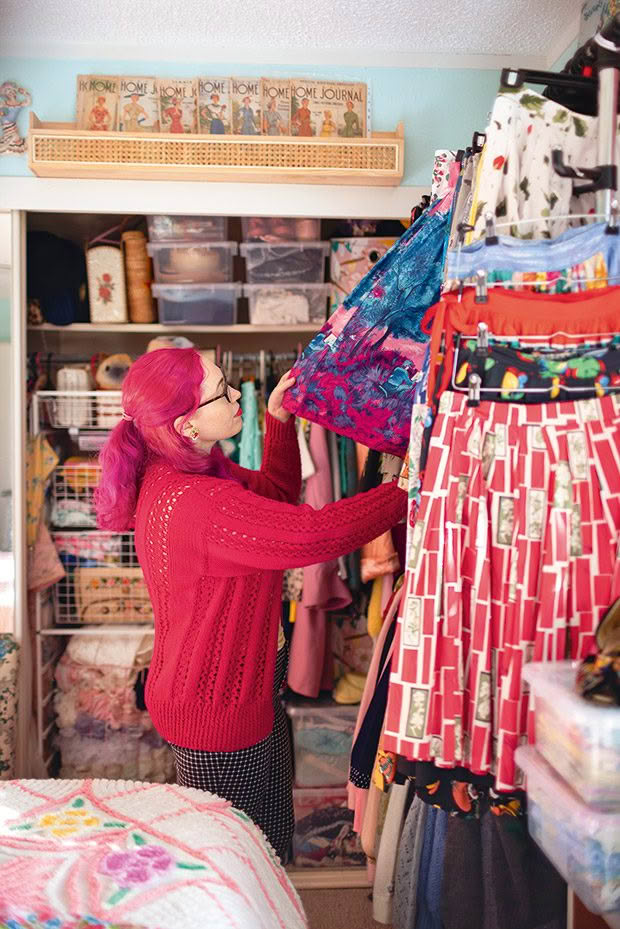
Natalie’s vintage clothing collection is stored in her wardrobe and on an extra clothes rack. Her extensive assortment of brooches and bangles takes up most of her lowboy and is interspersed with hats and bags. Just as well Tyler doesn’t have a vintage clothing collection.
◆ “I tend to wait until I’m having a good (for me) day, and then we hit 10 to 15 op-shops in a row. I only buy things I love and keep the budget pretty small. Like everything else, prices have increased a lot, so sometimes I come home with only a few things, but the freedom of getting out and about makes up for that. It’s like being a ‘real’ person for a few hours.”
◆ “I’ve found it useful to look in every section of a shop as you can find treasures in unexpected places. There are no good or bad shops; it changes every visit. A shop may be empty one day and then full the next.
◆ “Don’t buy things just because they’re cheap; only go home with things you want or need.”
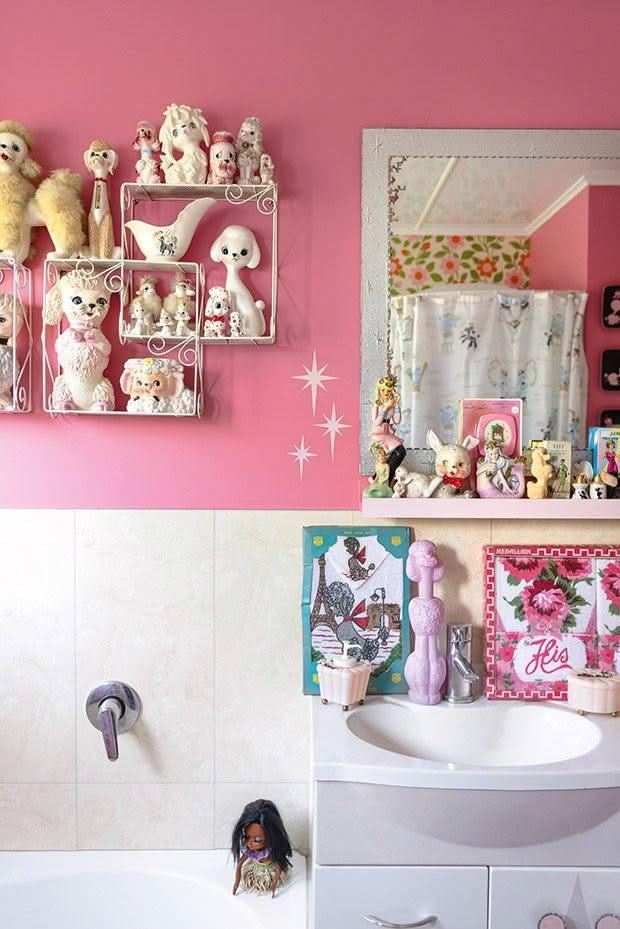
Natalie’s bathroom is a poodle-lover’s heaven. From the 1960s to the 1980s, the poodle was the most popular dog breed in the United States, featuring predominately in clothing and décor.
“Picking an era is not necessary; I think the best houses are a mash-up. If you choose colours, styles and objects you love, you can’t really go wrong. I would encourage people to embrace what makes them happy (even if it’s a bit weird) and not worry about trends, what is fashionable or what other people think.
“Don’t feel like you must have white walls when in your heart you want sunshine yellow. Don’t want a neutral bathroom? Go wild as I did with a mid-century poodle theme. I hate rules where certain things are deemed un-adult, too childish, or one I get a lot — ‘granny’. I think it’s ridiculous.”
RARE DISORDERS
Now 37, Natalie has struggled with undiagnosed debilitating tiredness since she was 13 and eventually did her schooling via correspondence to fit in with her irregular sleep cycle. Her Ehlers-Danlos Syndrome (EDS) was similarly undiagnosed. While something was recognized as wrong, it was attributed to some inherited familial affliction, as both her mother and sister also suffered from joint pain.
Natalie’s pregnancy put almost unbearable stress on her joints, and she also suffered from hyperemesis gravidarum, where she was unable to keep neither food nor drink down for her entire pregnancy, which left her weighing just 40 kilogrammes when Lily was born. It wasn’t until her daughter was a couple of years old that Natalie was diagnosed with Non-24-Hour Sleep/Wake Disorder (ND-24) and EDS shortly after.
The 13 types of EDS are a group of rare, mostly inherited, conditions that affect the connective tissues supporting skin, tendons, ligaments, blood vessels, internal organs and bones. Sufferers have overly flexible joints that can easily dislocate, and stretchy and fragile skin that easily tears but doesn’t hold surgical stitches well. There’s no treatment for EDS, but symptoms can be managed.
ND-24 is a circadian rhythm disarray where the body becomes desynchronized from the environment. Whereas most people’s cycle follows a 24-hour sequence, with sleep mostly dictated by the light of day and dark of night, ND-24 sufferers get out of sync. Over days or weeks, their circadian rhythms become desynchronized from regular daylight hours.
Several weeks later, they may not show any symptoms at all as their internal clock catches up with daylight once more. ND-24 is most common in people with total blindness due to the lack of light input reaching the internal clock but sometimes affects sighted people with other chronic conditions.


